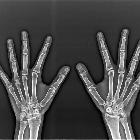Galloway-Syndrom





Galloway-Mowat syndrome (GAMOS) is a rare autosomal recessive disorder characterized by nephrotic syndrome and central nervous system (CNS) abnormalities, namely microcephaly.
Epidemiology
Galloway-Mowat syndrome is considered extremely rare. Approximately 40 cases have been reported worldwide .
Clinical presentation
Typically, microcephaly and CNS abnormalities are present from birth, with associated severe psychomotor impairment and seizures. However, microcephaly may occur later in development . Treatment-resistant nephrotic syndrome generally presents in the third month of life, but albuminuria may be present from birth .
Pathology
Etiology
Five monogenic mutations have been implicated in the pathogenesis of Galloway-Mowat syndrome. WD repeat-containing protein 73 (WDR73), which is a critical scaffold component of protein-complex assembly, was the first to be identified . Recently, mutations in four genes encoding the four subunits of the kinase, endopeptidase and other proteins of small size (KEOPS) complex have been identified in 32 families affected by Galloway-Mowat syndrome . KEOPS is essential to the function of transfer RNA and therefore protein translation and cell growth . The exact mechanism of pathogenesis is unclear.
Radiographic features
A range of structural CNS changes have been reported, including gross abnormalities of cerebral parenchyma - cerebral atrophy, encephalomalacia, porencephaly - and defects in neuronal migration - agyria, microgyria, polymicrogyria .
Treatment and prognosis
There is no treatment for Galloway-Mowat syndrome . Affected individuals may survive for one year .
Siehe auch:

 Assoziationen und Differentialdiagnosen zu Galloway-Syndrom:
Assoziationen und Differentialdiagnosen zu Galloway-Syndrom:


